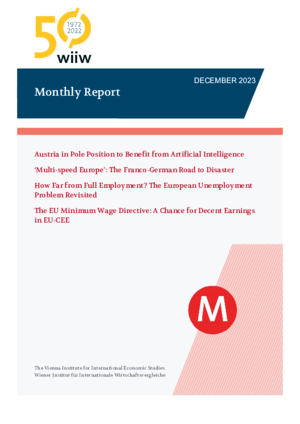Monthly Report No. 12/2023
Meryem Gökten, Sebastian Leitner, Jan Muś and Stella Sophie Zilian
wiiw Monthly Report No. 12, December 2023
53 pages including 1 Table and 32 Figures
- Chart of the Month: Austria in pole position to benefit from artificial intelligence
by Stella Zilian
- Opinion Corner: ‘Multi-speed Europe’: The Franco-German road to disaster
by Jan Muś
The ‘multi-speed Europe’ expert proposal commissioned by France and Germany has outlined the institutional and procedural reforms that the EU would need to implement, in order to prepare for future enlargement. While individual elements of the proposal make perfect sense, collectively they could potentially be disastrous, given the current international climate. By excessively strengthening the leverage of ‘core’ member states – such as France and Germany – over the rest of the EU, their implementation could result in a deepening of the EU’s internal divide between the poor and the rich.
- How far from full employment? The European unemployment problem revisited
by Meryem Gökten
Using the Beveridge curve concept, we find that European countries last experienced full employment in the 1970s, with the subsequent decades marked by elevated unemployment. After the COVID-19 crisis, only a few EU member states (such as the Netherlands and Czechia) and the US have achieved full employment; most EU member states still have considerable labour-market slack. Among other things, our analysis highlights the contribution made by hysteresis effects, trade union density and right-wing government policies to greater labour-market slack, and suggests there is no trade-off between inflation and unemployment – whatever the classical Phillips curve suggests.
- The EU minimum wage directive: A chance for decent earnings in EU-CEE
by Sebastian Leitner
Collective bargaining in EU-CEE has been under pressure over the past two decades, with coverage rates much lower nowadays than in Western and Northern European countries. Moreover, in-work poverty and wage dispersion have been on the rise. The EU Minimum Wage Directive, adopted in late 2022, is an important step forward in addressing these problems, by promoting collective bargaining and increasing statutory minimum wages. However, its success will ultimately depend on the willingness of national governments to accept unions and employer organisations as equal partners and to respect their autonomy in wage setting.
- Monthly and quarterly statistics for Central, East and Southeast Europe
Reference to wiiw databases: wiiw Annual Database, wiiw Monthly Database
Keywords: artificial intelligence, digital devices, complex cognitive tasks, EU institutions, majority voting, EU enlargement, full employment gap, Beveridge curve, Phillips curve, minimum wage, collective bargaining, in-work poverty
Countries covered: EU, EU-CEE, United Kingdom, US, EU accession candidates
Research Areas: Labour, Migration and Income Distribution
